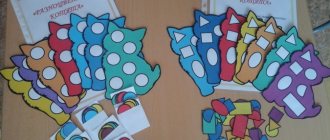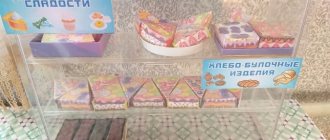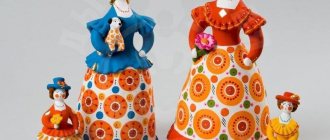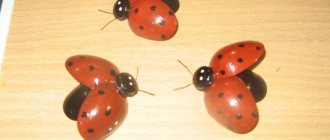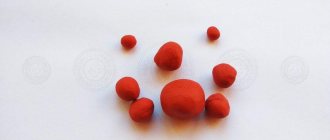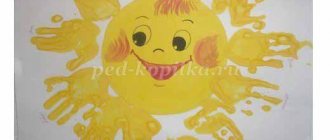Master class Methodology for composing riddles using TRIZ technology methodological development
Municipal budgetary preschool educational institution kindergarten "Golden Fish" in Tsimlyansk
___________________________________________________________________
347320 Rostov region, Tsimlyansk, st. Oktyabrskaya, 39 tel. (291) 2-49-08 INN 6137006469
Master Class
Methods for composing riddles using TRIZ technology
Educator: Boldina E.A.
2019
The purpose of the master class: to provide the opportunity to use TRIZ methods for composing riddles using reference tables using the example of the topic: “Riddles as a means of developing the speech of preschool children.”
Tasks:
— introduce the features, methodology, algorithm for composing riddles for children, forms of work;
— show with specific examples how to write riddles (electronic presentation) in work on speech development.
Practical significance: this master class may be of interest to educators and teachers who are specialists in working on the speech and intellectual development of preschool children.
During the master class, the methodology (algorithm) for composing riddles for children in different ways using reference tables will be demonstrated.
Predicted result of the master class:
- teachers get an idea of the methodology for composing riddles for children using reference tables in different ways in their work on the speech development of children:
— intensifying the introduction into the educational process of educators of methods and techniques for activating the intellectual and creative abilities of children.
Organizational moment, message of the master class topic
— Good afternoon, dear colleagues!
— I am glad to welcome you to our master class.
— One ancient Chinese proverb says: “Tell me and I will forget, show me and I will remember, let me do it and I will understand.”
— These wise words can be taken as a motto, a condition for successful work with preschool children, since it is through demonstration, observation and their own practical activity that the child develops.
“And we, preschool teachers, are creative, restless people, and in our work with children we often follow the proverb: “It’s better to see a hundred times than to hear a hundred times.” Or better yet, do it a hundred times.
— Therefore, today I would like not just to tell, but to show and give the opportunity to practically try out some of the methodological techniques that I use in my work with children on speech development.
— But before I announce the topic of today’s master class, I would like to ask you: about whom can this be said?
Educates, but is not a parent
Teaches, but is not a teacher
Studying, but not a student
Playing, but not a child. (TEACHER)
— What genre of literature do you think this text belongs to? RIDDLE. Today we will look at the methodology for composing riddles using TRIZ technology. A riddle is a means of developing the speech of preschool children.
General characteristics of the riddle
— In my work with children, I, like all educators, often use such small forms of folklore as nursery rhymes, fairy tales, counting rhymes, tongue twisters, proverbs, including riddles.
- Let's remember a little, what is a riddle?
— A riddle is one of the small forms of oral folk art, in which the most vivid, characteristic signs of objects and phenomena are given in an extremely concise, figurative form.
— Types of riddles: folk and original.
— Types of riddles:
- Descriptive, for example:
My caftan is green,
And the heart is like red
Tastes sweet like sugar
And he himself looks like a ball. (WATERMELON)
- Riddles - onomatopoeia, for example:
Behind the glass door
Someone's heart is beating.
Someone's heart is beating
So quiet
So quiet. (WATCH)
- Riddles - rhymes, for example:
In the underground, in the closet
She lives in a hole
Gray baby
Who is this? (MOUSE)
- Riddles are reversals, riddles are fables, for example:
We wound the wool into a skein
A silk scarf will come out.
Answer, is it true? (NO)
— The use of riddles is a very effective form in working on the speech development of children.
Puzzles:
- enrich children’s vocabulary due to the ambiguity of words;
- help to see the secondary meanings of words;
- form ideas about the figurative meaning of the word;
- help to master the sound and grammatical structure of Russian speech, forcing you to focus on the linguistic form and analyze it.
“But I believe that a riddle not only allows you to solve the problems of children’s speech development, but also, most importantly, brings joy to the child.
- And a riddle is a game, and the game, as we know, is the leading activity of children. A game of recognition, guessing, exposing what is hidden and concealed, what is presented in a different image, a different quality. And you don’t just need to find out, you need to guess before, from—guess.
“But when using riddles, I discovered that many children, even children of older preschool age, do not know how to solve riddles, although older preschoolers already have certain knowledge and intellectual skills sufficient to solve riddles.
— Specifically, the following problems emerged:
- listen inattentively to the text of the riddle;
- do not completely remember the content of the riddle;
-do not fully or partially understand the text of the riddle;
- when guessing and comparing, not all features present in the riddle are used;
- cannot correctly analyze, compare and generalize the features indicated in the riddle.
— Considering that a riddle is a kind of game, I decided to teach children to play riddles: not to guess them, but, on the contrary, to invent them using the well-known TRIZ methods, which I want to introduce you to today.
- So how to play riddles? Let's now try to compose riddles using the reference tables.
Methodology for composing riddles about TRIZ technology
Ι STAGE. Preliminary work: teach children to compare objects “What does it look like?”
For example: “I have a fur hat in my hands. What does it look like? (on a kitten, on a crocodile, on a snowdrift, on a bear’s den). Simply answering the question is not enough. We must prove that the hat looks like a crocodile. “Which side do you have to look from to see a crocodile? Where is his tail? What is he doing now?
STAGE II. Algorithm for composing riddles using reference tables
First model:
1. Drawing up a reference table of the form:
| "Which? (which?, which?)" | “What is it? » |
2. Selecting an object (included on the top line - for reading children, for others - a picture or a schematic drawing). For example:
SUN
3. Filling out the left side of the table: “Which?”
| "Which" | “What is it? » |
| Bright Round roast |
4. Filling out the right side of the table: “What is bright (round, hot), but not the sun?”
| "Which" | “What is it? » |
| Bright Round roast | Lamp Wheel fire |
5. Insertion of “words - connectives” - AND NOT. Making a riddle about the sun
Riddle: What is this?
Bright, not a lamp?
Round, not a wheel?
Roast, not fire?
Second model
1. Drawing up a reference table of the form:
| "What is he doing?" | “Who does the same action?” |
2. Selecting an object (included on the top line - for reading children, for others - a picture or a schematic drawing). For example:
MOSQUITO
3. Filling out the left side of the table: “What does it do?”
| "What is he doing?" | “Who does the same action?” |
| flies Squeaks Bites |
4. Filling out the right side of the table: “Who does the same action?”
| "What is he doing?" | “Who does the same action?” |
| flies Squeaks Bites | Airplane Mouse dog |
5. Insertion of “words - connectives” - AND NOT. Compose a riddle about a mosquito.
Riddle: What is it?
It flies, not an airplane?
It's squeaking and not a mouse?
It's the dog that bites, not the dog?
Third model
1. Drawing up a reference table of the form:
| “What does it look like?” | "What is the difference?" |
2. Selecting an object (included on the top line - for reading children, for others - a picture or a schematic drawing)
For example:
COMB
| “What does it look like?” | "What is the difference?" |
3. Filling out the left side of the table: “What does it look like? (on the fence, on the saw, on the grass)
COMB
| “What does it look like?” | "What is the difference?" |
| Fence Saw grass |
4. Filling out the right side of the table: “What’s different?”
COMB
| “What does it look like?” | "What is the difference?" |
| Fence Saw grass | Can't climb Doesn't saw Doesn't grow |
5. Insertion of “words - connectives” - HOW, BUT. Making a riddle about a comb
Riddle: What is this?
Like a fence, but you can't climb.
Like a saw, but doesn’t saw,
Like grass, but it doesn't grow.
Work in subgroups.
Now I invite you to become pupils and try to compose riddles using reference tables yourself in subgroups using this technique.
Words: apple, cat, car.
So, colleagues, let's see what you got. I suggest you ask the composed riddles to each other.
— Tell me, what speech problems did you solve when composing riddles? (teachers' answers).
- How can you play riddles? Various forms can be used.
Forms of working with children to write riddles:
- Compiling riddles collectively for one guesser.
One child is sent out the door. The teacher and the children select an object and discuss how to create a riddle. The object is hidden, a child is invited and one of the children asks a riddle.
- Compiling and telling riddles for children to each other in two teams or subgroups.
- Compiling house riddles using reference tables. Parents are actively involved in this work.
— So, colleagues, I suggest you exchange information:
- What were we doing with you now?
- How did we do it?
- Thus, a riddle is a real high creativity, accessible to preschool children.
Guessing and inventing riddles has an impact on the diversified development of children's speech. The use of various means of expressiveness to create a metaphorical image in a riddle (the device of personification, the use of polysemy of words, definitions, epithets, comparisons, special rhythmic organization) contributes to the formation of figurative speech in preschool children.
Analysis of the riddle helps not only to better understand and guess it faster, but also teaches children to pay attention to the word, arouses interest in figurative characteristics, helps to remember them, use them in their speech and create an accurate, vivid image themselves.
Summing up the master class, reflection.
— Returning to where we started, that is, with the motto of our master class: “Tell me and I will forget, show me and I will remember, let me do it and I will understand,” I would really like today’s information you found it interesting, useful, and most importantly, helped you in your creative work with children.
— I really like the words of E. Ermolova: “How to communicate with a child? Yes, it’s very simple: captivate until you get carried away. The richer and more multi-layered the classes are at first, the more freedom in the process and the greater talent as a result.” I wish you success and creativity in your daily work with children!
And for my further pedagogical work, I will ask you to evaluate today's master class. Reflection:
"Dear Colleagues! I ask you to evaluate the event by filling out the table using the expressions “yes”, “no”, “partially”. Thank you in advance!
| Satisfied with today's work | Gained theoretical knowledge | I can design teaching activities on this topic |
TRIZ tasks for adults
- A barber in a small Italian town always said that he would rather cut and shave two tourists than one local. Why? (Answer: because the payment for two clients is more than for one.)
- One day my son rode a bicycle from the city to the village. An hour later, the father rode out to meet his son from the village to the city, also on a bicycle. They met in a roadside cafe. Which of them will be closer to the city if they were driving at the same speed? (Answer: at the same distance.)
- There were two black grouse sitting on a tree. The hunter shot one of them. How many birds are left on the tree? (Answer: most likely, none. When shot, birds usually fly out of the trees.)
How to choose subsystems and supersystems
When choosing a system, there must be an understanding of its function. That is, why the system was created, what it does. In this case, there may be several functions, this is also important to take into account. It all depends on who this function is aimed at. And then, based on the function and problem that exists in the system, we begin to build subsystems. If we want to improve passenger comfort through interior convenience, then it is more important to look in detail at the interior elements than the engine. Then there will be passengers in the supersystem, and not the driver. It is very important to select only those objects of subsystems and supersystems that have a significant impact on our system. And our system actively interacts with them and, accordingly, influences them. In this way, a model is built from objects that are interconnected and influence each other. This allows us to greatly simplify the visualization process, which increases the focus of attention to where the most powerful solution to our problem sits.
Troubleshooter's talented thinking
The minimum is 9 screens that Troubleshooter sees when solving the problem. If this is not done, you may miss something significant from the past, or you may not see the requirements of the supersystems of the future. All this will lead to a weak solution, when, like TRIZ, it is always only about strong solutions. A correctly constructed multi-screen is a guarantee of finding resources, thanks to which the task is correctly set to solve the problem. And the more screens, the more resources, which means the treasured solution will be found faster. Let's practice!

